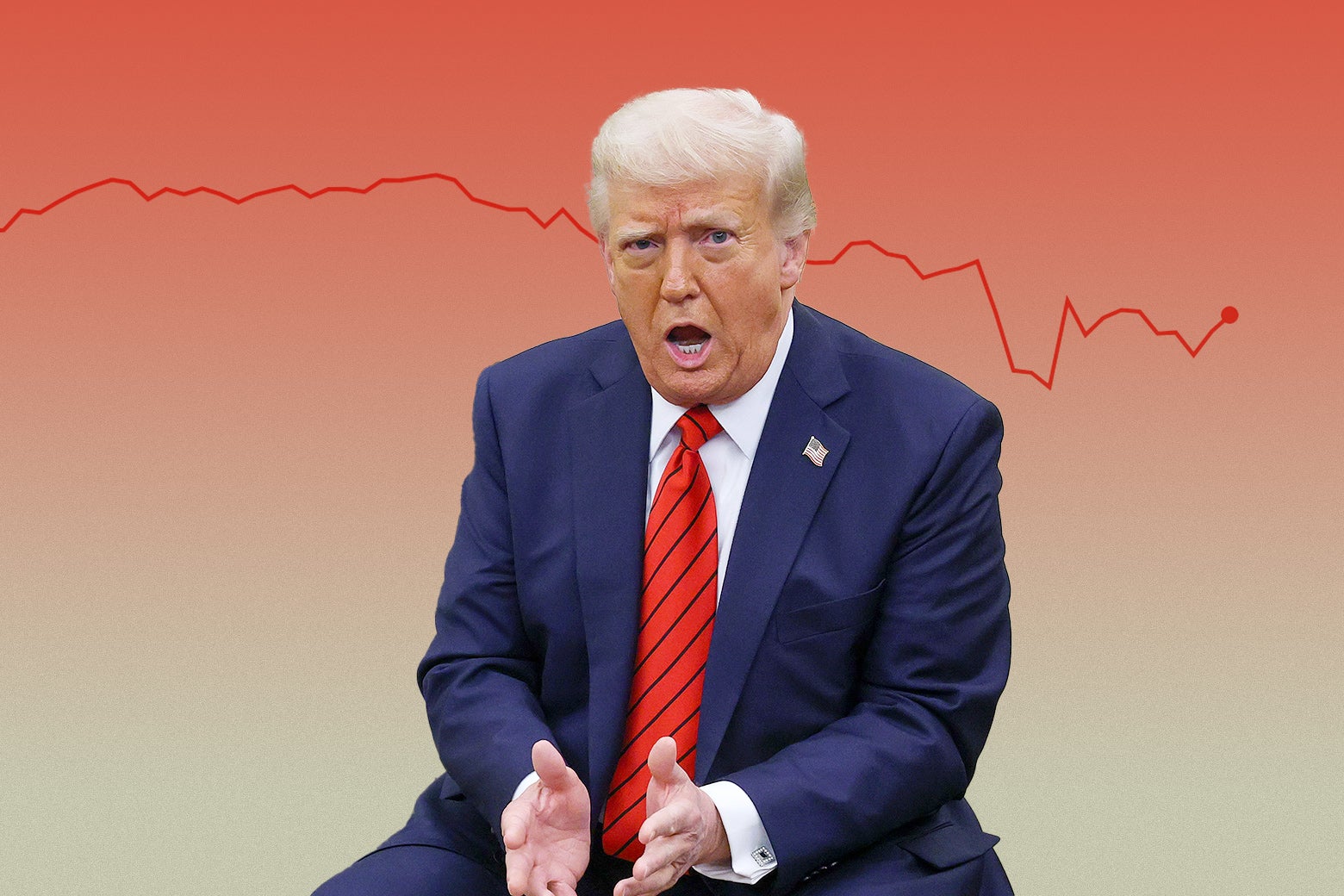Sign up for the Slatest to get the most insightful analysis, criticism, and advice out there, delivered to your inbox daily.
Come back with me, if you will, to one of the many Trump dramas that has dominated the past couple of weeks—whether or not the president would fire Federal Reserve Chairman Jerome Powell. Supposedly President Donald Trump was gearing up to do so because he was unhappy with how Powell was steering the Fed to respond to Trump’s tariffs, but on Tuesday, Trump announced that he had “no intention” of firing Powell after all, closing a depressingly familiar loop of outrageous maneuvering, ominous market turmoil, and, ultimately, humiliating retreat.
This loop is now standard operating procedure from the most chaotic White House in American history. In fact, it seems to be more or less the only move that this iteration of Trump has, one that he is deploying against everyone from Canada to Harvard University. And it is eerily similar to the nuclear strategy concept of “escalate to de-escalate” —using a shocking act of aggression to convince an adversary to negotiate on your terms.
In nuclear strategy, “escalating to de-escalate” is part of the shift from the older doctrine of “mutual assured destruction” that governed American policy in the early Cold War to a more flexible policy that attempts to ensure a nuclear exchange that doesn’t necessarily spiral out of control to Armageddon. Instead of a single trigger that would plunge the world into a nuclear holocaust, theorists like Herman Kahn imagined a “ladder of escalation” that decision-makers could climb up—and, crucially, climb back down. Though the basic idea initially described what would happen to, say, Russia, if it faced a conventional attack that it could not counter—and instead responded to with small-scale nuclear response—in recent years, the phrase has been used to describe the fear that a cornered Vladimir Putin might use smaller, battlefield nuclear weapons against Ukraine if Russia’s position in the war deteriorates—not to start a global cataclysm, but to force Kyiv to negotiate for peace on terms Moscow can live with.
All of the theory behind escalating to de-escalate is related to the highly consequential threat of nuclear warfare. The problem for Trump is that he is using it well outside of those bounds, and it really is not working for him. His opponents are taking note of his weakness and adjusting to the exhausting policy churn and administrative incompetence by routing their long-term planning around the United States altogether.
Last Monday, he tried this tactic again, calling Fed Chairman Jerome Powell “a loser” for not lowering interest rates and preparing to fire him (a move that would almost certainly be declared unconstitutional by the Supreme Court). With markets once again in a tailspin from his capricious threats and ill-considered decision-making, Trump caved and promised he wouldn’t try to cashier Powell. His treasury secretary, Scott Bessent, also goosed markets by saying that the trade war with China is “not sustainable” and that he anticipates (wait for it) “de-escalation.” But Beijing claims that there are no discussions underway and seems in no hurry to relieve the economic and political pressure the Trump administration has brought completely on itself.
The lesson here, as any parent who has used a version of this tactic on a young child knows perfectly well, is that “escalate to de-escalate” is not a very effective strategy at all, in almost any domain. “I will take away your TV in the morning if you don’t brush your teeth” is ultimately a hollow threat because following through on it hurts you as much as, if not more than, it punishes your kid. Even if it works once, the recipient of escalatory threats quickly comes to understand that they can call your bluff. If it was a useful tactic, Russia would already have deployed it against Ukraine, and China would have come scurrying to the negotiating table to plead with Trump to reduce tariffs.
As Daniel Post argued last year for the Bulletin of the Atomic Scientists, for leaders on the receiving end of “escalate to de-escalate” aggression “giving in to such a demand comes with higher reputational costs than does refraining from retaliation” and “exacerbates worries over precedent setting and future vulnerability.” Many countries are already on at least their second round of Trump using abusive tactics to force trade concessions. At this point, they know that capitulating will only lead to new demands via the moving of goalposts and have no confidence that any deal struck today will be respected tomorrow. That is true for China, it is true for Harvard, and it is true for anyone or anything targeted by Trump’s lawless and unpredictable regime.
Issuing a never-ending stream of escalatory and often nonsensical threats is also no way to run a country, and voters are fast coming around to the understanding that they made a terrible mistake putting this senescent maniac back in power in November. Even if Trump walks back all of the tariffs tomorrow morning, the resulting chaos and uncertainty is likely to take an ongoing economic toll.
It is not clear how the United States will even survive another 44 months of this circus with anything resembling the status quo, or our battered psyches, intact. But if Trump’s incipient authoritarians ever allow another Democrat to be elected president, that person is likely to discover that some of the damage to America’s reputation and interests is irreversible.

